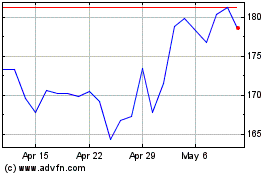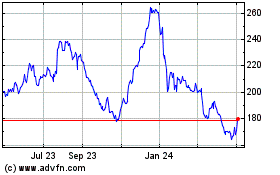By Robert Wall and Doug Cameron
The aviation industry is bulging with orders for new planes. If
only it can get them made.
There were so many almost-finished jetliners, missing their
engines, piled up at an Airbus SE factory in Germany last May that
executives joked they were in the glider business. It ceased to be
funny when a frustrated Qatar Airways canceled orders for four
planes that were months overdue.
"It is making a huge impact on my bottom line. We are, quite
frankly, screaming," said the airline's chief executive, Akbar Al
Baker.
After years of surging orders, including many from fast-growing
Asian and Mideast airlines that sought fuel-efficient jets when oil
prices were higher, the aviation industry is heaving under the
strain. By the end of the decade, Airbus and Boeing Co. must build
30% more planes annually than they do now to meet existing orders,
in one of the industry's steepest production increases since World
War II. The scale of the ramp-up is putting companies to the
test.
Suppliers of seats, toilets and engine parts are stretched to
the limit and sometimes falling short. In one of the worst holdups,
Pratt & Whitney, an engine supplier for a hot-selling new
Airbus model, informed the European plane maker in September it
would ship only 75% as many engines in 2016 as planned.
Both Boeing and Airbus are making adjustments to cope, retooling
factories and tightening oversight of their globe-spanning supply
lines. Boeing said at the beginning of 2016 it would make fewer
planes during the year than in 2015. The move sent Boeing's stock
to its steepest drop in 14 years, though it has since
recovered.
Airbus fell so far behind on its 2016 production schedule it had
to rush out more than 100 planes in December to meet the year's
target. It took the unusual step of increasing staffing at
factories in the final weeks of the year, including the holidays,
and told suppliers to do the same.
Airbus's newest version of its workhorse A320 offers new
engines, but the company had 20 of the planes still waiting for
engines at year-end. By cranking out more older models, filling
back orders, it managed to meet and even exceed its 2016 target of
670 planes.
Today, the yearslong order bonanza pressuring manufacturers
shows signs of tailing off, but that doesn't relieve the urgency to
deliver ordered planes as quickly as possible. Manufacturers
collect most of a plane's price only when they ship it. For Airbus,
cash flow ran steeply negative for much of last year because so
many airliners weren't getting to customers.
Also, for the fiercely competitive Boeing and Airbus, on-time
delivery can keep buyers loyal instead of turning to the arch rival
or to emerging plane producers in China, Russia and Canada. Qatar
Airways, after the Airbus delays, decided to buy some Boeings, a
new 737 model called the Max.
Qatar Airways' Mr. Al Baker blames both of the big two for not
being ready for the order boom, which was fed by low interest rates
in addition to the higher fuel prices of prior years. The
inexpensive financing spurred purchasing by airplane-leasing
companies, which buy about 40% of new planes.
In 2011, Mr. Al Baker ordered 50 Airbus A320 airliners with new,
more fuel-efficient engines, called the A320neo -- an order trimmed
to 46 after his cancellations last year. "Both Airbus and Boeing,
in order to mitigate their risk, will have to start investing in
the industry in order to have a more diversified supply chain," Mr.
Al Baker said.
Airbus, based in Toulouse, France, has moved around shifts and
vacation time for factory workers to align them better across its
manufacturing centers. It may dedicate more resources to
"supporting and understanding proactively possible hiccups with
suppliers in the future," said Tom Enders, the chief executive. He
asked his chief operating officer, Fabrice Brégier, to personally
supervise suppliers.
"We need to educate" them, Mr. Brégier said. "They are on their
way. Some need to continue to make efforts."
At Boeing, meanwhile, Chief Executive Dennis Muilenburg has
staff members and consultants scouring for potential problems that
might delay the first delivery of the 737 Max, expected as early as
May.
In the frenzy to deliver on time, minor snafus can cascade into
big problems. Trouble has arisen with seats, toilets and in-flight
entertainment systems, all in short supply at various times.
Hit by a 2014 strike at a Texas seat maker, France-based
aviation-parts supplier Zodiac Aerospace SA was late delivering
business-class seats, which cost about $100,000 each, for new
Boeing 787s headed to American Airlines Group Inc. in 2015.
Typically, airlines buy seats directly from suppliers but have them
shipped to the airplane manufacturer.
The delay pushed back deliveries of the 787s by four months and
held up fitting new seats in some 777 jets. American switched seat
suppliers. The airline declined comment. Boeing now is backing a
startup seat-maker to prevent shortages.
Zodiac also was late delivering seats and lavatory doors to
Airbus for its A350 long-range jet, at a time when Airbus was
sharply raising production of that plane in 2015. One of the first
buyers, Finnair, received the planes late.
Zodiac's chief executive, Olivier Zarrouati, said his company
relied too heavily on assurances from subsidiaries that make the
parts but has since fixed the problems. Zodiac agreed in January to
be acquired by Safran SA, a French maker of airplane parts, which
has pledged to help Zodiac overcome its problems. The acquisition
still needs shareholder and regulatory approval..
Nothing has been more disruptive than the Pratt & Whitney
engine issue. When Airbus set out several years ago to rejuvenate
its popular 165-seat A320, by giving buyers a choice of two new
engines, orders for the A320neo far outpaced expectations.
For one engine option, Airbus picked CFM International, a joint
venture of General Electric Co. and Safran. For the other, it chose
the Pratt & Whitney unit of United Technologies Corp.
Pratt & Whitney struggled with making the engine fan blades,
which initially took twice as long as managers had expected. The
company said this is improving and extra capacity is coming on
stream to meet its new target.
United Technologies' chief executive, Gregory Hayes, said in
January that it was back on track after struggling with parts
issues. Pratt & Whitney delivered 138 engines in 2016, down
from the planned 200, but expects to build 350 or 400 this year.
The company on Feb. 1 replaced the head of its commercial aircraft
engines business.
CFM also shipped fewer engines than planned last year, 77
instead of about 100. Output is scheduled to jump to more than
2,000 by 2019. CFM this month named a boss to oversee the process
after the contract for the prior head of the joint venture ended.
One CFM plant, outside Lafayette, Ind., is trying to cut in half
the 20 days needed to turn out an engine.
Airbus managed to deliver 68 A320neo airliners last year,
including 39 with the Pratt & Whitney engine. After Qatar
Airways' cancellation of its initial orders, Deutsche Lufthansa AG
became the first airline to take delivery.
This year should be smoother, though delays are likely to
persist, said Airbus's Mr. Brégier. The company expects to triple
its output of the A320neo and build more than 700 airliners in
all.
Boeing, which delivered 748 planes last year, expects this to
rise to 760 to 765 in 2017 as it boosts production of the 737 from
the third quarter, with further increases planned over the next two
years.
--Ted Mann contributed to this article.
Write to Robert Wall at robert.wall@wsj.com and Doug Cameron at
doug.cameron@wsj.com
(END) Dow Jones Newswires
February 23, 2017 16:45 ET (21:45 GMT)
Copyright (c) 2017 Dow Jones & Company, Inc.
Boeing (NYSE:BA)
Historical Stock Chart
From Mar 2024 to Apr 2024

Boeing (NYSE:BA)
Historical Stock Chart
From Apr 2023 to Apr 2024
